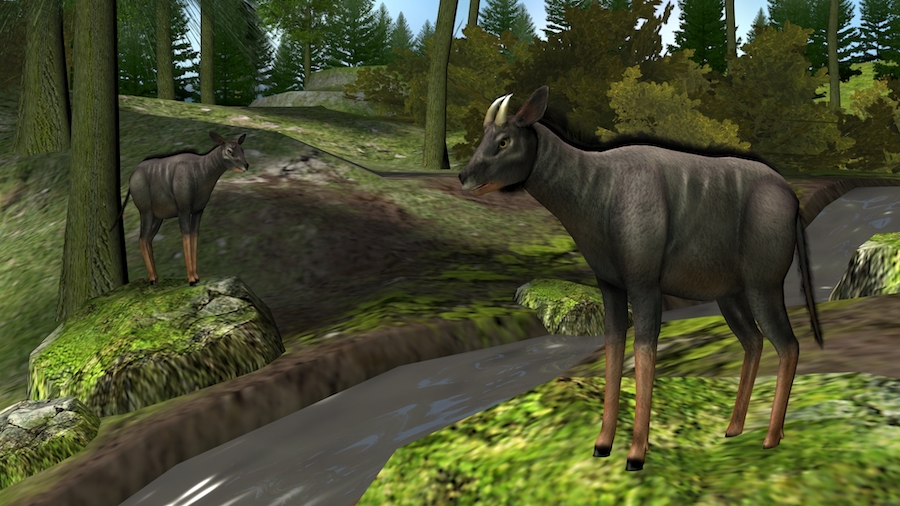News
21.04.2020
How the goat-like gorals of the Himalaya can be better protected
University of Tübingen researchers suggest giving them open grasslands to live in
The Himalayan Goral, the Chinese Goral and the Sumatran Serow are three goat-like species which live in the highlands and mountain forests of southeast Asia. A new study shows that these may not be their preferred habitat. Indeed, the animals may have retreated to the last places available to them. That’s the result of investigations into how earlier populations of gorals and serows lived between several hundred thousand and ten thousand years ago. The study was headed by Dr. Kantapon Suraprasit of Chulalongkorn University in Thailand and the University of Tübingen, and by Professor Hervé Bocherens of the Senckenberg Centre for Human Evolution and Palaeoenvironment at the University of Tübingen. The species in question are vulnerable or threatened. To help protect them, the researchers recommend moving the remaining populations to open grasslands at lower altitudes. The study has been published in the latest edition of Frontiers in Ecology and Evolution.
The research team investigated the teeth of earlier populations of goral and serow in an age range of 400,000 to 6,000 years ago. The samples were taken from fossils from five sites in Thailand: Pha Bong, Khok Sung, Tham Wiman Nakin, Tham Lod Rockshelter, and Ban Rai Rockshelter. Isotopic analyses of the carbon and oxygen on the tooth enamel are recognized methods of finding out more about the diet and lifestyle of animals both ancient and modern. If the animal feeds on leaves, the tooth enamel stores different carbon isotopes than if the diet consisted mainly of grass.
Isotopic analyses showed that the Sumatran Serow (Capricornis sumatraensis) was a generalist in the Pleistocene. “This species ate both leaves and grass. It appears to have been happy with various habitats such as forests and grasslands,” says Kantapon Suraprasit. Today’s population of Sumatran Serow only lives in mountain forests. The isotopes told a different story for the Himalayan Goral (Naemorhedus goral) and the Chinese Goral (Naemorhedus griseus) in the Pleistocene. “We were surprised that these two species ate mostly grass and appear to have lived only in open landscapes,” Suraprasit says, adding that they live today in both low and high mountain forests, on steep slopes and rocky cliffs or at extremely high mountain grasslands, up to 3,000 m above sea level.
Driven out by humans
“Climate change in the Early Holocene meant more precipitation in Thailand and more closed forests,” says Hervé Bocherens. He suggests that may have been a factor contributing to the gorals’ change of habitat and finally local extinction in Thailand. Yet the researchers believe the effects of human activity had an even greater influence. “The hunting of goral and the agricultural and commercial exploitation of their original habitat in the lowlands led to the population decline of the species. The rest of the animals in what is now Nepal and Bhutan were forced to withdraw into the higher regions of the Himalaya,” says Bocherens.
The populations and the geographical range of the near-threatened Himalayan Goral and the vulnerable Chinese Goral were rapidly reduced. These findings from palaeontological research should be used to help protect them, the researchers say. The negative influences of human activity need to be cut back and a new protection plan developed for the gorals, giving them access to grassed areas in the lowlands.
Publication:
Kantapon Suraprasit, Jean-Jacques Jaeger, Rasmi Shoocongdej, Yaowalak Chaimanee, Athiwat Wattanapituksakul and Hervé Bocherens: Long-Term Isotope Evidence on the Diet and Habitat Breadth of Pleistocene to Holocene Caprines in Thailand: Implications for the Extirpation and Conservation of Himalayan Gorals. Frontiers in Ecology and Evolution. https://dx.doi.org/10.3389/fevo.2020.00067
Contact:
Kantapon Suraprasit, PhD
Chulalongkorn University – Department of Geology
University of Tübingen – Department of Geoscience – Palaeobiology
suraprasit@gmail.com
Professor Dr. Hervé Bocherens
University of Tübingen
Department of Geoscience – Palaeobiology
Senckenberg Centre for Human Evolution and Palaeoenvironment
Phone +49 7071 29-76988
herve.bocherens@uni-tuebingen.de
Contact for press:
Eberhard Karls Universität Tübingen
Public Relations Department
Dr. Karl Guido Rijkhoek
Director
Janna Eberhardt
Research Reporter
Phone +49 7071 29-76753
Fax +49 7071 29-5566
janna.eberhardt@uni-tuebingen.de
www.uni-tuebingen.de/en/university/news-and-publications
Senckenberg Nature Research Society
Press Office
Dr. Sören Dürr
Director
Judith Jördens
Phone +49 69 7542 1434
judith.joerdens@senckeberg.de
pressestelle@senckenberg.de
www.senckenberg.de/presse

